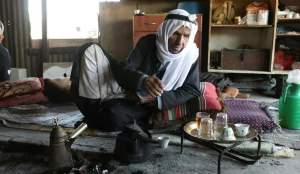‘We Will Die Here’: Bedouin Village Fights Israel Resettlement Plan

Freij Al Hawashleh, an elder in the Bedouin village of Ras Jraba.Credit: Eliyahu Hershkovitz
Only a few hundred meters separate Dimona’s Hashahar neighborhood from the unrecognized Bedouin village of Ras Jrabah. For decades, the villagers have had close ties to their neighbors from the city across the way. Many of them work in Dimona and the village gets its water, mail and health care services from the city. These ties are now being tested in the shadow of authorities’ plans to expand the city and build a huge neighborhood where the village now stands.
Dimona Mayor Benny Biton opposes villagers’ demand to find them space in the new neighborhood, Rotem, which is expected to contain about 11,000 housing units on about 2,471 acres. Because of his opposition, in 2019 the Israel Lands Authority filed suit to evict some 550 residents of the village, most of them members of the Al Hawashleh tribe and some from Abu Sulb and Al Nasarna tribes, on the grounds that they were squatting illegally. About half of Ras Jrabah’s residents are children.

The Bedouin Settlement Authority has offered the villagers compensation for their eviction: lots of 5,360 square feet in the towns of Qasr al-Sir and Arara Benegev, plus 250,000 shekels (about $74,793). The compensation is intended for each of the 90 families who live in Ras Jrabah and eligible individuals over the age of 18. But residents say they would rather move to Dimona.
“All our lives we’ve helped people from Dimona and have had a good relationship,” said Freij Al Hawashleh, one of the elders of Ras Jrabah. “We supplied them with water from the well, goat’s milk, they bought sugar and tea from us and got any help they wanted. What happened now that they want to house people at our expense?”

Freij said the inhabitants have lived in Ras Jrabah since as far back as the British Mandate, which began in 1918 and ended in 1948. “Our whole lives we raised flocks, took care of the land and planted trees,” he said. “They want to take our land and humiliate us and they expect us to be silent, but we will stay here and we will die here.”
Another resident, Ibrahim Al Hawashleh, said, “They’ll move us to a place we’re not used to and then the problems will start, our social situation will change. Many Bedouin who have moved to the Bedouin cities have deteriorated into crime.”
“There’s no crime, violence or drugs here,” Ibrahim added. “We won’t let them change our lives and our culture. We’ll stay and raise animals and earn our living from animals. That’s how we were raised. We’re Bedouin and the sons of Bedouin.”
“Why not give us an agricultural village that belongs to Dimona?” said Musa Al Hawashleh, chair of Ras Jrabah’s governing committee. “We’ll pay for water, we’ll pay city taxes, we’ll pay everything. We don’t need much space. There aren’t many people here.”
“They say this is state land – no problem. We’re also citizens of the state,” said Musa. “Let them find us a proper solution, not cast us aside.”
Last week, during court hearings on the Lands Authority’s suit to evict the residents, NGOs presented an aerial photo that they say proves Ras Jrabah was founded no later than the 1950s. The Lands Authority claims the village was established between the early 1960s and 1970s, and Dimona Mayor Benny Biton says Ras Jrabah has only existed for the past 25 years.
Architect Dafna Saporta, an expert witness, said making Ras Jrabah an official part of Dimona is “the most practical, logical, economical and moral solution for the residents of the village, for the residents of Dimona and for the state.”

A 2008 report by the Goldberg Committee, tasked with finding official solutions for Bedouin residence in Israel’s southern Negev desert, recommended recognizing the unrecognized Bedouin villages as much as possible. Committee chair Judge Eliezer Goldberg then said the claim about tribes squatting in the area was erroneous. Nevertheless, courts have continued to reject all such claims to recognize land ownership. The result has been a situation full of inherent contradictions, including Israel’s refusal to recognize the villages or compensate their residents.
The Al Hawashleh tribe launched its legal land-ownership fight near Dimona at the end of the 1960s, in an effort to register the lands in their names rather than as state land. All the rulings on the matter have defined the land as “dead lands,” according to Ottoman law, over which ownership cannot be claimed. The most recent such ruling, from the Supreme Court, was in 1984. These rulings do not take into consideration 1940s British Mandate land surveys, which indicated that Bedouin cultivated about 2,000 square kilometers in the Negev.
Biton, the Dimona mayor, said he believes any arrangement within the city “would be like a prize to squatters on Dimona municipal land 25 years ago and since then have treated it as their own.” He added that giving the land to the Bedouin, and not Dimona residents who have served in the Israeli army, would be “inconceivable” to him. He claimed the Bedouin are asking “only for rights and not obligations” and said they can bid on other lots of land with the settlement being offered to them.
Ibraham Al Hawashleh said that in fact at least 20 residents of Ras Jrabah have served in the Israel Defense Forces and that one villager died during his service. He himself served in the Bedouin Desert Reconnaissance Battalion and went on to serve in the career army for two years, he added.
This article is published in its entirety
